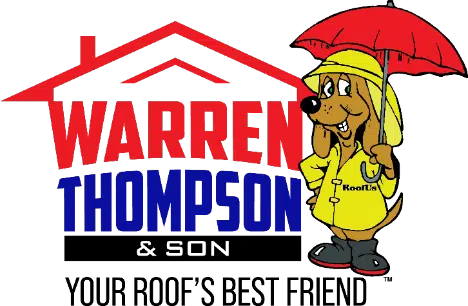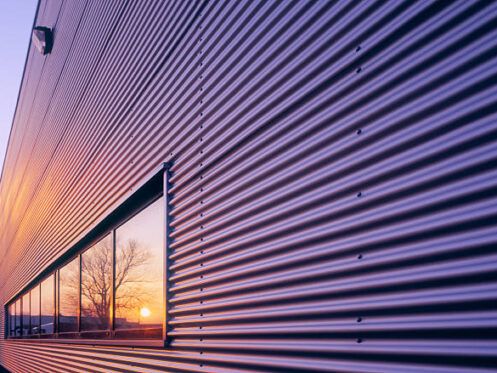Metal siding offers a number of benefits to commercial building owners. Understanding these benefits and getting some answers to frequently asked questions about metal siding can help you choose the best option for your property.
1. Longevity and Affordability
Commercial building owners have several siding options to choose from. Vinyl siding tends to last anywhere from 20 to 40 years. Brick veneer and stucco siding can last for up to 100 years or longer with regular maintenance, but they aren’t very budget-friendly. Metal siding, on the other hand, is much more affordable and can last for up to 60 years with proper care.
2. Lightweight and Simple Installation
Metal siding is notably lighter than other siding materials such as brick, stone or concrete. This lightweight characteristic simplifies installation processes, reducing labor costs and construction time. It also decreases building structural stress, allowing for greater design flexibility and sometimes reducing the need for extra support systems.
3. Low Maintenance Requirements
Vinyl siding typically requires minimal maintenance, primarily consisting of occasional cleaning with soap and water to remove dirt and mildew buildup. Periodically inspecting for cracks or damage is advisable, and straightforward repairs involve replacing individual panels as needed.
Brick veneer siding demands moderate maintenance, including regular inspections for mortar erosion or cracks and occasional repointing to ensure structural integrity. This repointing involves removing deteriorated or damaged mortar from the joints between the bricks and replacing it with fresh mortar. Stucco siding maintenance involves periodic cleaning to prevent mold and mildew growth, as well as inspections for cracks or chips that may require patching to prevent moisture infiltration. Fiber cement siding requires occasional cleaning and repainting every 10 to 15 years to maintain its appearance and protective coating.
Metal siding, on the other hand, boasts minimal maintenance requirements due to its inherent durability. Occasional washing with soap and water helps preserve its appearance, while inspections for loose fasteners and damaged panels ensure structural integrity.
4. Energy Efficiency and Sustainability
Metal siding typically has a high degree of reflectivity, meaning it can bounce sunlight away from the building. During warmer weather, this lowers solar heat gain and keeps the inside cooler while also minimizing energy usage due to excessive air conditioning. Metal siding also comes with the option to add insulation. By decreasing heat conduction through walls, insulated metal panels help maintain consistent interior temperatures and reduce workloads on HVAC systems. Moreover, metal siding’s tight structure prevents air penetration and reduces drafts and heat loss in winter. All of these advantages improve the building’s energy efficiency.
5. Versatility in Design and Aesthetic Appeal
Metal siding gives architects and designers a lot of leeway to create the appearance they want for commercial buildings, thanks to its adaptability and aesthetics. You can personalize it to meet the building’s architectural style and branding by choosing from a variety of colors, textures and profiles during manufacturing. Another architectural versatility offered by metal siding is its installation options, which can be horizontal, vertical or even diagonal. Its contemporary design works well with current architectural trends while also harmonizing with more classic and industrial styles.
6. Pest, Fire and Weather Resistance
Metal siding’s durability prevents damage from pests like termites and rodents, ensuring structural integrity and reducing the need for costly repairs. Metal siding also offers important fire protection due to its non-combustibility, which reduces fire hazards and improves occupant safety. In addition, it can withstand wind, rain and UV radiation without degrading. This makes it ideal for long-term use while cutting down on maintenance expenses and downtime.
7. Higher Resale Value
The added durability of metal siding guarantees that the building will maintain its structural integrity over time. This increases its resale value by offering reassurance to potential buyers about the long-term stability of the property. Plus, the modern charm of metal siding can captivate buyers in search of visually striking properties, potentially boosting resale value.
8. Warranty Protection
Manufacturers usually provide robust warranties for metal siding products that cover defects in materials and workmanship for extended periods. In the event of any issues arising from manufacturing defects or improper installation, the warranty serves as a safety net. This helps building owners concentrate on their primary business activities rather than siding matters.
What Types of Buildings Work Best With Metal Siding?
Metal siding is a versatile option suitable for various types of buildings, but some types may benefit more than others. Industrial facilities, warehouses and agricultural buildings often utilize metal siding due to its durability and low maintenance requirements. Commercial properties like retail stores, office buildings and shopping centers can benefit from the modern aesthetic and long-term performance of metal siding. Overall, any building seeking a durable, low-maintenance exterior with a sleek appearance can benefit from metal siding.
What Factors Should You Consider When Choosing Siding?
Longevity, ease of maintenance, affordability, energy efficiency and aesthetics are all factors to consider. Many building owners choose metal siding because of its minimal maintenance requirements and high durability. Insulated metal panels might be a good choice if you’re looking to improve the building’s energy efficiency. When it comes to aesthetics, metal siding offers a lot of options in terms of color, texture and profile. Last but not least, while budgeting, it’s important to include the whole cost, which includes installation, maintenance and any possible energy savings.
Is It Easy to Repair Damaged Metal Siding?
The level of difficulty in fixing damaged metal siding varies with its severity. Delicately reshaping or painting the impacted area is usually enough to fix little problems like dents or scratches. Nevertheless, if the damage is substantial, such as holes or rust, it could be necessary to replace the panels.
Can You Recycle Metal Roofing?
Yes, metal siding is highly recyclable at the end of its life span. Metal recycling facilities can process old metal siding materials, melt them down and repurpose them for new products. Recycling metal siding helps reduce waste and conserve resources, making it an environmentally friendly option.
Are There Any Considerations for Insurance Coverage or Premiums Related to Using Metal Siding?
Insurance coverage and premiums related to metal siding can vary depending on factors such as the building’s location, local building codes and the specific insurance provider. Generally, metal siding’s durability and resistance to fire and weathering can lead to lower insurance premiums compared to other siding materials.
Does Metal Siding Have Any Impact on the Building’s Acoustics or Sound Insulation Properties?
Metal, by itself, isn’t the most effective sound barrier when compared to materials like brick or concrete due to its density and inherent properties. However, insulated metal panels can significantly dampen sound transmission and improve the building’s overall acoustics. These panels typically consist of a metal exterior with a layer of insulation, such as foam or mineral wool, sandwiched between them.
When you need help with siding, roofing, storm damage or commercial roofing in Alpha, NJ, call Warren Thompson & Son Roofing & Siding.

